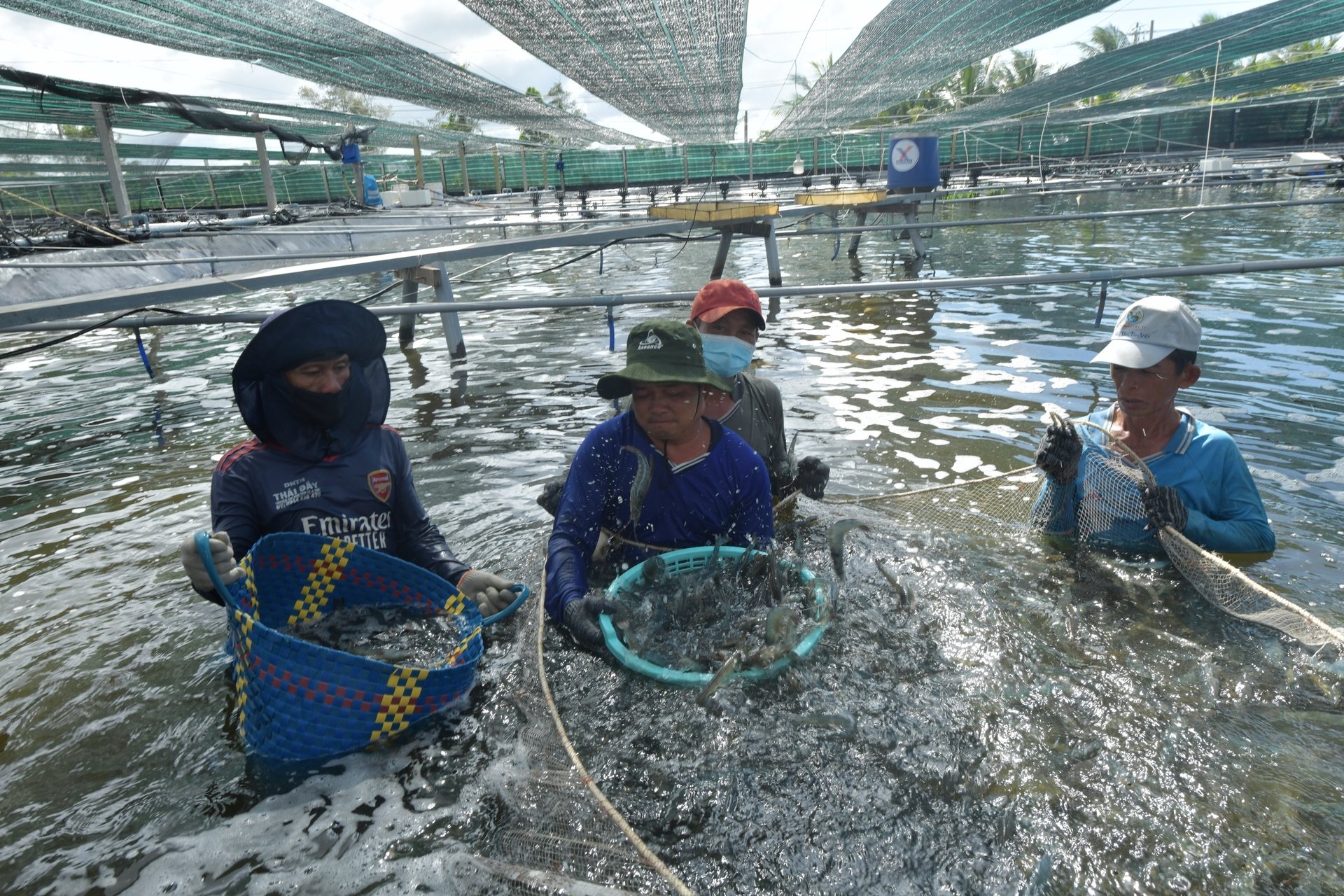November 24, 2025 | 13:19 GMT +7
November 24, 2025 | 13:19 GMT +7
Hotline: 0913.378.918
November 24, 2025 | 13:19 GMT +7
Hotline: 0913.378.918
According to a report from the Ministry of Agriculture and Rural Development, Vietnam produced 837.4 thousand tons of seafood in August 2023. This is an increase of 2% over the same period in 2022. Accordingly, the fishing output reached 351.6 thousand tons, which is a decrease of 0.5%; the farming output reached 485.8 thousand tons, which is an increase of 3.8%.
Within the first eight months of 2023, Vietnam produced approximately 5.93 million tons of seafood, which is an increase of 1.9% over the same period in 2022. Accordingly, the fishing output reached nearly 2.63 million tons, which is an increase of 0.3%; farming output reached nearly 3.3 million tons, which is an increase of 3.8%.

Mr. Tran Dinh Luan, Director of the Directorate of Fisheries, emphasized the difficulties in acquiring new seafood orders. Photo: Hong Tham.
According to a report made by the Ministry of Agriculture and Rural Development, Vietnam's seafood export turnover reached 750 million USD in August 2023. This is a decrease of 24% over the same period in 2022. Furthermore, the total seafood export turnover in the first eight months of 2023 reached 5.68 billion USD, which is a decrease of 25.4%.
Ms. Le Hang, Communication Director of VASEP, detailed two scenarios for Vietnam's seafood exports in the second half of 2023. According to the favorable scenario, Vietnam's total seafood export turnover in 2023 will reach approximately 9 billion USD, which is a decrease of 15 to 16% compared to that of 2022. Namely, the export of shrimp is projected to reach 3.5 to 3.6 billion USD, a decrease of 16 to 18%; pangasius 1.7 to 1.8 billion USD, a decrease of 28%; tuna, squid, and octopus 870 million USD and 650 million USD, respectively, a decrease of 14 to 15%; marine fish 1.9 to 2 billion USD, a marginal decrease compared to that of 2022.
Major markets for Vietnamese seafood are expected to bring in lower revenue compared to that of 2022. Accordingly, exports to the US and South Korean markets decrease by 24 to 25% compared to that of 2022. Exports to the European market will decrease by 18%. Conversely, exports to the Japanese market have expanded thanks to the emergence of value-added goods as well as the processing segment specializing in marine fish species to support this market.
On the other hand, China continues to be the largest market for Vietnamese seafood businesses. After this country re-opened its market, trade activities have gradually recovered. China's economy is expected to slowly stabilize towards the end of the year, resulting in an increase in both income and consumption demand. Subsequently, Vietnam's seafood exports will have the opportunity to recover with an expected export turnover of approximately 1.8 billion USD for both the Chinese and Hong Kong markets by the end of 2023.
Regarding the less favorable scenario, the recovering market will stimulate the demand for seafood. However, Vietnamese seafood products will struggle to remain competitive with other countries such as Ecuador, India, Indonesia, Thailand, and so on in terms of price and supply.
Vietnam's seafood industry is currently facing problems without immediate and long-term solutions including high production costs due to high input costs for feed and seed; declining profits; lack of capital to maintain investment for continuous crops; abandoned farming areas leading to a shortage of raw materials in the second half of the year, etc.
According to the second scenario, Vietnam's seafood export turnover is projected to reach only 8.5 to 8.7 billion USD by the end of 2023. Additionally, the two most affected industries would be that of pangasius and shrimp. Furthermore, Vietnam's export of seafood would also be severely affected if the EC's inspection results for Vietnam's anti-IUU fishing program in October 2023 failed to remove the "yellow card".
During the August's briefing at the Ministry of Agriculture and Rural Development, Mr. Nguyen Nhu Tiep, Director of the Department of Quality, Processing and Market Development, reported: "Two inspection teams from the Europe and the US have recently examined Vietnam's fisheries system. Subsequently, the European inspection team discovered serious issues that arose after the Covid-19 pandemic. However, it has been determined that these problems are unlikely to have an impact on Vietnam's export of seafood. As a result, businesses can continue to export under stricter measures".
Mr. Tiep added: "The US inspection team focused on Vietnam's catfish system. They have concluded that the system is functional with a few insignificant errors, and we are still eligible to export catfish to the US."

Vietnam's export of shrimp is projected to reach 3.5 to 3.6 billion USD by the end of 2023, which is a decrease of 16 to 18% over the same period in 2022. Photo: Thanh Cuong.
Mr. Tran Dinh Luan commented: "The US inspection team also found no major flaws in Vietnam's pangasius production system”.
Regarding the plans for the agricultural sector for September 2023, Mr. Tiep said: "We have recently promoted development in three major markets: Europe, America and China. In the immediate future, the Department of Quality, Processing and Market Development will continue to develop the Guangxi market by signing a memorandum of understanding on agricultural development and agricultural product trade. Additionally, we aim to promote the Yunnan market."
Mr. Luan added: "Vietnam's seafood export turnover reached nearly 1 billion USD in July 2023. However, this figure dropped to only 750 million USD in August 2023. Businesses are currently experiencing difficulties acquiring new orders. As a result, it is necessary to review the seafood raw material area in a flexible manner for September 2023 in order to satisfy better markets and orders"
“On the other hand, after Japan's releasing of wastewater in the Fukushima nuclear power plant, the structure of global seafood import and export has changed markedly. We will need to carefully assess new opportunities for Vietnamese seafood", Mr. Luan concluded.
According to Mr. Tran Dinh Luan, the Directorate of Fisheries will continue to implement tasks such as: Install electronic traceability software at fishing ports, starting with a pilot model of tuna value chain in Binh Duong province; make preparations to welcome the EC's inspection team in October; develop models of seaweed farming, deploy co-management models in coastal provinces and cities, and fish farming models in reservoirs, etc.
Translated by Nguyen Hai Long

(VAN) The agricultural sector is finalizing the strategic framework for emission reduction, setting the goal of sharply cutting methane and 403.7 million tons of CO2 equivalent and moving toward Net Zero by 2050.
/2025/11/22/2236-1-153832_483.jpg)
(VAN) The National Marine Spatial Planning is opening up opportunities for sustainable blue sea development across 21 coastal localities.

(VAN) Viet Nam’s forestry sector is undergoing a comprehensive transformation, strengthening management, protection, and development efforts to maintain ecological security and drive green, sustainable growth.

(VAN) Viet Nam is accelerating efforts to digitize reservoir operations, from real-time data to hydraulic modelling.
/2025/11/21/3348-2-102623_454.jpg)
(VAN) National Assembly delegate Nguyen Thi Lan has proposed adding special mechanisms to attract human resources to the agricultural, forestry, and fishery sectors, addressing the shortage of high-quality personnel.

(VAN) Over the past two decades, the unified legal framework for water resource management has been perfected, becoming a crucial foundation for ensuring national water security.

(VAN) The land-data cleansing campaign in Dien Bien is entering its final stretch, yet weak infrastructure, limited personnel and fragmented multi-period datasets continue to create major obstacles.